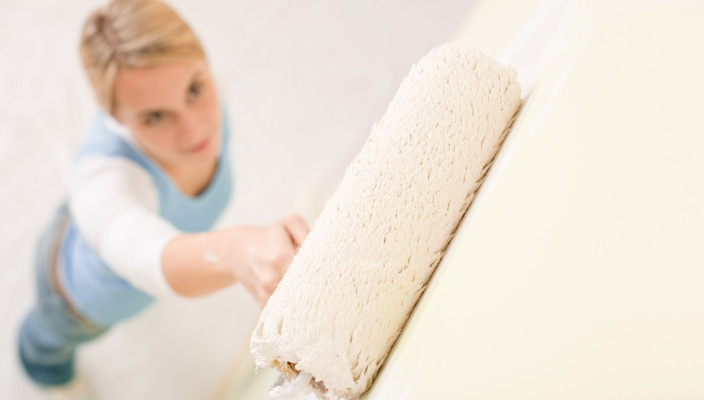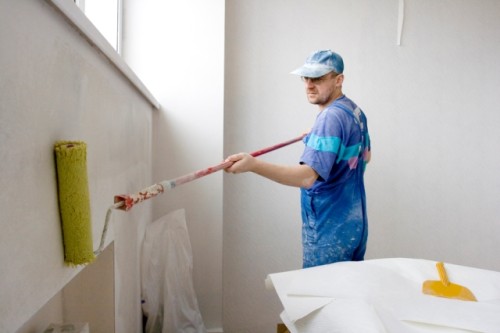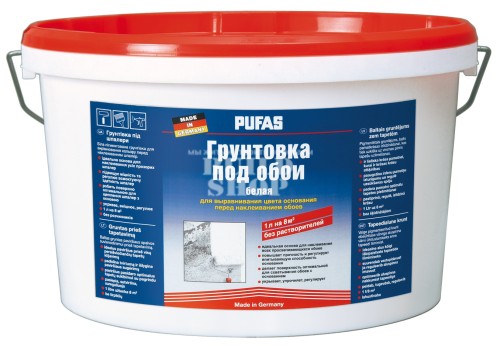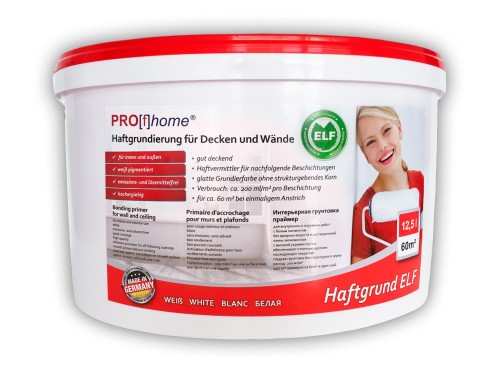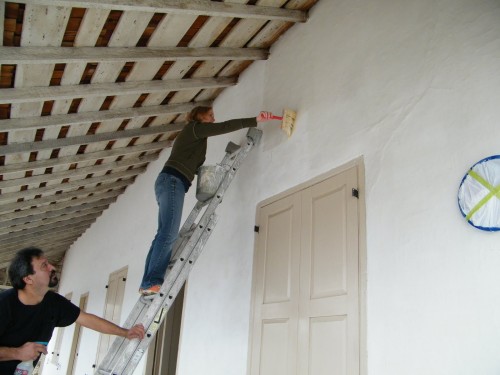Sometimes there is a question during the repair, whether it is worth the grinding walls before falling down with wallpaper. Previously, their canvases were fixed with the help of ceiled celers, which also performed as a primer coating for the walls. Nevertheless, the modern market is filled with a significant number of diverse finishing materials. Fit the suitable primer composition, you can achieve the most qualitative result of the wicker walls.
Content
Why do you need to grab the walls under the wallpaper
It is possible to glue wallpaper on various types of walls, but at the same time it is required to prepare them accordingly in order to get solid and durable, if possible, a smooth base surface under the decoration. Experts claim to prepare a proper surface of the walls before applying the final coating, regardless of the planned method of finishing, it is required to apply priming. This stage of repair work is very important, and they should not be neglected.
It can be noted several reasons why it is necessary to apply primer under the wallpaper:
- the walls that are planned to stick the finish finish in the form of wallpapers, as a rule, differ in a sufficiently porous structure capable of actively absorbed the adhesive composition. As a consequence, with waters, the efficiency of their fixation is reduced and the volume of consumable glue increases. Printed on the walls of the primer under the wallpaper qualitatively fills the pores of the treated surface and strengthens it, creating a protective film and acting as an obstacle to penetration of glue mixture - thus, the strength of the walls and the degree of adhesion of the wallpaper of wallpaper with finishing materials increases, while the glue falls uniformly and its flow rate is noticeably reduced;
- even with the most thorough preliminary preparation of the walls, microscopic dust particles are usually present on them, which create an inhomogeneous surface when applying glue, worsening the quality of wallpaper gluing (subsequently increases the likelihood of their peeling). In the priming of the walls, such dust is isolated under the layer of primer coating, the surface is reinforced and in the future the dust layer does not contact directly with glue;
- many types of primer contain antiseptics in their composition, preventing reproduction on walls under the wallpaper of various pest microorganisms in the form of fungus or mold;
- the primer coating of white color will help to align the shade of the walls, remove traces of spots (for example, from fat, soot, rust and mold), which is especially important when choosing the finishing of walls in the form of light half-floating wallpaper;
- a qualitatively primed surface allows wallpaper canvases for some time when sticking to the walls to remain elastic and slide on the surface, i.e. The wizard will have the possibility of fitting wallpaper for optimal placement;
- priming allows you to increase the stability of walls with the brake walls to the differences in humidity and temperatures in the room.
As a rule, the lack of preliminary preparation of walls in the form of priming is manifested most noticeable (detachment and appearance of air bubbles) in places of bends of wallpaper wallpapers in the field of angular joints of the walls. Thus, you should not try to save some time and means neglecting the execution of priming, otherwise, soon after the work there may be a need for a new repair. On the contrary, the use of primer will allow to achieve the highest quality result of the wicked walls.
What is the primer under the wallpaper
The primer is a mass with a homogeneous composition, which includes various universal components, as well as fillers. The primer compositions are intended for the qualitative change in the properties of the surface being treated, including under the salary of wallpaper. Regardless of the type of basic surface under such a finish, it needs priming, allowing to significantly strengthen the surface of the walls, optimize the glue distribution on it and significantly improve the final result of finishing with wallpaper.
The primer coating protrudes on the walls as a "binder", largely increasing the adhesion of walls with wallpaper. Thus, pre-priming will help to avoid unpleasant surprises in the form of cracks and breaks on wallpaper, detachable and peeling the canvas.
How to choose a primer under the wallpaper
The modern market for finishing materials offers a wide selection of different priming compositions. To prepare the basic surface of the walls, it is important to choose the most suitable primer.
Varieties of primer under the wallpaper
After analyzing the specific conditions - the state of the base surface under the finishing, the type of material of the walls and the planned finish, it is easy to choose the best primer under the wallpaper. You can purchase a universal soil that is suitable for processing different types of surfaces, but such a composition will usually cost more. For the preparation of walls under the wake-ups, the primer-primer is used (for the primary trim of the base surface), as well as primer compositions to improve the adhesion of the decoration layers.
The following varieties of primer are presented on sale:
- acrylic - this type of soil based on acrylic polymers is universal, as it is suitable for any base (from drywall, wood and concrete to paint and plaster). The exceptions are only surfaces of ferrous metals, as they appear rust due to the processing of this type of soil. Treatment of the surface of the walls with such a primer will provide high-quality preparation for them under the wake-up and excellent grip with trim. Acrylic primer under the wallpaper will quickly dry (in a few hours), without highlighting the unpleasant odor;
- alkid - optimally suitable for surface treatment of wood, chipboard and fiberboard. In addition, alkyd soil can be used to process such complex base surfaces as glass and galvanized steel. It should be noted that under the finishing of wallpaper it is necessary to use the alkyd primer composition based on chromates (the soil based on phosphates is used under painting). After applying the alkyd soil, the surface of the tree acquires susceptibility to various types of finishes, providing excellent adhesion with the sticked wallpaper. Such primer under the wallpaper dries within 10-15 hours. This type of soil is perfect for the preparation of the surface of the wooden walls of the house or cottage under further bolding with wallpaper;
- glyphthale - applied in rooms to prepare for finishing with surfaces of surfaces from various metals. Such primer coating dries during the day. This type of soil is suitable for processing surfaces of walls in rooms with low humidity;
- phenolic - used as a primer coating for processing the base surface from wood or metal. The drying time of this coating is 10-12 hours;
- waterproofing - this primer composition is used to treat the surface of the walls in rooms with high humidity (in bathrooms, saunas, etc.);
- the primer composition of deep penetration is used to strengthen not sufficiently dense surface (loose and porous);
- universal white - such a pigmented primer under the wallpaper is suitable for the preparation of the base surface from different materials with a small or medium porosity. When choosing, which primer for wallpaper is used for preliminary preparation of walls to finish with thin partially translucent wallpaper, for example, phlizelinov, it is worth preferring exactly pigmented. White primer under the wallpaper is convenient for use, as it perfectly masks a different type of stain on the surface treated and it allows you to qualitatively equalize the color of the walls. It is allowed to apply this soil to various bases, including painted walls, drywall or finishing in the form of old wallpaper. In addition, the white primer is suitable for the preparation of walls under the wake of wallpaper under painting.
In any case, professionals are recommended to give preference to a specialized primer composition, to the greatest extent suitable for the specific material of the walls of the walls.
Useful advice
Assessing the specifics of the walls, it is worth paying attention to the mode of temperature and humidity in the room (during the repair period and expected in the future). In addition, the regime of ventilation should be planned during operation, since many types of primer compositions can be distinguished by harmful evaporation.
Trying to save on the price of primer under the wallpaper, choosing the cheapest, hardly advisable. The use of a qualitative composition for priming will further extend the life of the finishing walls of the walls and will maximize the time of the next repair. Thus, to the decision-making, which primer to choose to choose, should be responsible. According to the reviews submitted, primary formulations of domestic manufacturers made on the basis of imported components are sufficiently popular. In addition, you can buy a primer under the wallpaper from the well-known foreign manufacturers, well-proven themselves.
The modern market for finishing construction and finishing materials offers primers in liquid, as well as dry. The second option is characterized by lower cost, but the primer composition will in this case, it will be necessary to dissolve water yourself - according to the instructions attached by the manufacturer. When buying, it is also worth paying attention to the consumption of primer at the rate of 1M 2 treated surface. Based on this indicator, as well as the area of \u200b\u200bthe walls of the room under the flooding wallpaper, you can calculate the required amount of primer. If you plan to apply several layers of material, it also needs to be considered when counting.
For applying a primer mixture, it is convenient to use a painting brush. In addition, it is possible to significantly speed up the priming process using a foam, velor or pile roller. To carry out such works, the container with the prepared primer is covered on top of a metal grid that holds small lumps of non-dissolved mixture during the roller perch. Optimize the process of applying primer on the walls is also easy to attach a telescopic pipe to the roller handle - in this case, you will not need to use the stepladder.
Before applying primer for walls, it is necessary to make preparatory work - carefully clean their surface from the old finish, peeling plaster and losing paint. The insufficiently dense and durable surface of the walls should be prepared for further decoration using special primer compositions of deep penetration. These work must be carried out by protecting the open areas of the skin with clothing and putting protective gloves - to avoid irritation or an allergic reaction. The primer mixture will be required evenly on the surface of the walls. If the strengthening of porous parts of the walls was strengthened, it is necessary to wait for their misses and then you can apply primer to the entire surface of the walls under the finish.

